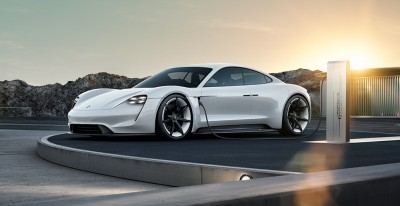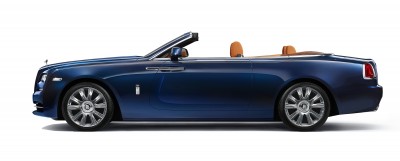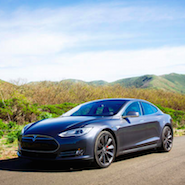A recent survey of 800 senior executives in the automotive sector listed digital connectivity and electric vehicle powertrains as the two most important trends, according to a new report by L2.
Last year, the same categories ranked only ninth and tenth, a testament to how suddenly the two topics have come to dominate the conversation. As a whole, the automotive industry is slower to capitalize on the possibilities of digital technology than other sectors, a reality that may in part be due to differences in product.
"This change in focus is no accident," L2's report states. "Last year, millennials drove 27 percent of new car sales in the United States, displacing Gen X as the second most influential group of buyers behind boomers."
"Among millennials auto shoppers, 72 percent have considered a hybrid or electric vehicle, 62 percent would pay more for Internet-enabled vehicles, and 41 percent leverage mobile devices to inform purchase decisions (remotely and at the dealership)," it continues. "While individual buyer considerations fluctuate by age group, the impact of digital remains fixed. Across all drivers, 75 percent suggest they would consider conducting the entire car-buying process online."
“L2 Digital IQ Index: Auto” looks at survey data from executives to determine automotive trends, provides digital IQ data for 58 brands in the United States, United Kingdom and Europe, analyses of digital marketing, social media and mobile sites and a “Flash of Genius” section detailing more closely successful campaigns or features.
Riding the brakes
Of the 800 respondents, who hail from 38 countries, 50 percent rated connected car technologies as “extremely important,” a huge jump from 8 percent in 2015. The jump for battery electric mobility also shot up, from 9 percent to 47 percent, with a smaller but related increase in fuel cell electric mobility.
Connected car technologies have recently been implemented by both Tesla (see story) and Mercedes (see story), while even brands known for their speed have target dates for electric vehicles, including Aston Martin (see story) and Porsche (see story).

Porsche Mission E
Of connected cars, the report finds that the majority of applications that allow consumers to connect their smartphone and vehicle require monthly or yearly payments, with Tesla being the only brand eschewing payment and continually updating. Consumers expect connected cars but are generally reluctant to pay, suggesting that automakers are looking for a revenue stream in the wrong place.
Other big trends cited are mobility as a service, which Mercedes, BMW and Audi have all recently begun practicing with new mobile apps, and autonomous driving. Last year, only 3 percent of executives saw autonomous driving as an extremely important trend, a far cry from the 38 percent who recognize it now.
The digital IQ of brands varied by country. In the U.S., those with the highest rank were mass-market U.S. and Japanese manufacturers, followed primarily by German brands. BMW’s investment in Instagram – they had 82 of the most popular Instagram posts in the sector – landed it a seventh place finish, with Mercedes and Audi finishing at 10th and 11th and Porsche further behind at 16th.
In general, luxury brands fared worse. Lexus finished 22nd with a score of 109, putting them in the “average” category, where Lexus, BMW Mini, Land Rover and Jaguar joined them. Maserati and Aston finished close to the bottom with scores in the “challenged range,” with Bentley, Rolls-Royce and Bugatti finishing at the bottom.
Luxury brands tended to perform better overseas, although the ultra high-end – McLaren, Rolls-Royce, Ferrari, Lamborghini, Maserati and Bugatti – consistently were placed at or near the bottom. For brands with high price points and an extremely limited run, getting the word out is not as important, as an ultra-wealthy, loyal clientele will likely make the purchase anyway and the relative lack of visibility might help foster exclusivity and mystery.

Rolls-Royce Dawn
Nevertheless, Rolls-Royce has begun to shift focus to the digital space to establish relationships with the next generation of consumers. A new responsive Web site (see story) and the unveiling of the new Dawn (see story) represent a shift in tactics.
Overall, L2 names Land Rover and Tesla as winners compared to digital IQ performance last year and Mercedes and Lexus as losers by the same measure. Tesla and Land Rover have both allocated resource to making mobile devices more usable and taken steps to improve advertising, while Mercedes and Lexus have lagged behind on mobile and social media fronts, respectively.
In Europe, new car registrations have grown for 28 consecutive months, and millennials have usurped Generation Xers as the second biggest buyers of cars, signifying a large demographic that is beginning to earn significant wealth. This shift, along with falling fuel prices, suggest that growth will continue, meaning it is essential that brands make themselves visible and attractive in the digital space where these new consumers live and boomers have gravitated.

Audi piloted etron R8
Among social media findings, U.S. users tend to be far more active on social networks, an ample opportunity for brands looking to expand their consumer base in the country, and paid advertising is the primary driver of YouTube views, as is the case in other sectors. Additionally, users naturally gravitate toward simple hashtags, namely brand and model names, whereas slogans without the same level of unawareness generally underperform in social campaigns.
On Facebook, an algorithmic newsfeed has led businesses to decrease the number of posts and back them with money so as to keep up engagement. Automakers have not responded the same way, with many saturating the platform with content that goes underfunded and thus under-seen.
Also of note, L2 finds that most brands have regional sites, at first glance suggesting successful localization, but in fact many key features are unique to only one region’s version.
Perhaps most importantly, mobile sites are lagging in the UK and continental Europe, and even those that do function are far less sophisticated. Car configurators, the option to schedule test drives, and 360-degree views of the vehicles are largely missing from European mobile sites. Mobile apps, meanwhile, have failed to make a splash.

Rolls-Royce mobile site
In more concrete terms, marketers are allocating a great deal of media spend to the brand's own name at both the brand and dealership level, meaning that expenses are being wasted on a costly term with little competitive interest. Generally, someone searching for "Audi" or "BMW" or any other brand by name is looking specifically for relevant results, paid or otherwise, and will ignore interference.
By contrast, only 1 percent of the time do brands have the top organic search result for unbranded popular search terms, such as "minivan" or "sedan." Such search terms are far more competitive, meaning visibility is more significant, yet Chevrolet, Dodge and Toyota are the only brands to have those short terms.
In another under-exploited opportunity, brands do not often partake in email marketing, yet it is a low-cost technique that accounts for 39 percent of leads for dealerships. While many solicit ZIP codes and models of interest and then push that information to the consumer's local dealership, follow-ups and offers to schedule a test drive or otherwise use the information are uncommon.
Pedal to the metal
Despite a handful of shortcomings, successful marketing campaigns tended to have an especially noteworthy impact. Although likely to die down in the time between films, a heavy James Bond-related push from featured automakers in the wake of the release of “Spectre” proved very successful.
British automaker Aston Martin is giving consumers one last chance to feel like James Bond.
On Feb. 18, Christie’s will celebrate the home video release of “Spectre,” the latest James Bond film, with a themed charity auction fronted by Aston Martin’s DB10. The auction will give Bond fanatics a chance to live their dream, while the spy’s popularity will ensure hefty earnings for a good cause (see story).
The James Bond association clearly works. L2 found that in November 2015, the month following film’s release, Aston Martin and Jaguar, two heavily featured brands that pushed their appearances heavily, saw traffic double compared to November 2014.
Although they may lag behind in the digital marketing space, luxury automakers are leaders in the race for autonomous vehicles by some measures.
German automakers Mercedes-Benz, BMW and Audi are among the leaders in strategy and execution in autonomous cars, with Tesla and Jaguar a bit further behind, according to a recent report by Navigant Research.
Although fully self-driving cars are still at least a decade away, pieces of the technology are already being implemented into vehicles today, meaning that the battle to be first is already waging. Because of the safety and ease of such a vehicle, the first brand to release an effective, fully autonomous car could capture a sizable segment of the market (see story).
"Our thesis is that digital competence is inextricably linked to shareholder value," the report says. "This study attempts to quantify the digital competence of 53 distinct Auto brands operating in the United States, United Kingdom, or Germany. Our aim is to provide a robust tool to diagnose digital strengths and weaknesses, helping managers achieve greater return on incremental investment."
{"ct":"4vVXZu6ZRYBYlumCaJXa2JkeM8Nhhc19TRtLtciVLYLd1zkTV1V2VJ0Thz5Ij5H8RBs1Wu\/P3GsA2z0mzObxUIgIhclZUsQTglO7Jm\/d0n7w7CJtMfQf5IgfQTSnOziUZpps3JZrZmQkwszo7QWENPLgVh\/EPSHbxGTNB9Or0qjsSqufyZznyRKOfmPqkxeH\/qU\/M7YsOywT1vJ5b8r0d+sJ86Xru1zrmylxIGeXznnHsva7AAd8vVQ\/zQsoLS9spiLBHoBJKIjFH9ED3YDBALNK4Icd4orrEe3qibVcBe7+iqgpkUDlcBG\/lHmgjlX5bRUTxWLphGpGyZfCWjuPB8WzGEVqDiJSV7yRIM2wIZ0DMdTC+BJgGCk7oCsToSg8A4msopJliw\/UKnA2E\/73Q5FHUle6DvUJsA2Igbq9ubxXZiXHoFhbzFoOxzC8sDp+smhuOIKjIJf1vBIG1Rvl4cAPfAXPQdwxdiDuqqDbQcJSeHLSELeSsTq24ZmDyJwMFDFrLZobhqqYwvwTEdtzlsTFg01gz7xYCRBGXe7cJwtOWd7wvixxrw3O6ZyYyblDPXOCUIFvLqnF+rHE3PTNmjkIfFqAcbXBIu6kY8HeQQ8N3dAPr39ELlLIUSbtC4lopVR6UZxYiMEn7AK8S8ZHFRHGRFYrljiGwAvQ4s5xCezrkVWu4cIMS+nPjkzJgNrqdQ5bgAkLrsyz0B3Zd3KK5NkuSok3gcD3Tj0zVGaStn2GnEio+rXHqgEcAcz8lSdVvwFJiVj6BoA3Zj1qnH91vp3VuIX+7fId+sgJCLGzx3ZbQretBvh\/j7PxOsW\/nELHhNHRHCtwXAWn8rnSAt+jq+F82sWtIX0OzI4W2kJcywpZPQb+GVfLXKG4OyZ5Uu0HLMI9BrfZ7erYSW10KAjIwm\/Gf\/9d5+sZRPgcNdTPJztj6v7Iyo8\/EnWOPnIxx++Uc0edMXGVM8lACj8GCHJQagrTd3BSzLfQUmhvDCHPRvtef9iMcI5yFGAwwG8wlKTAOh8AOb+d4aBZAS7fhP+YAMrLowezzpAtUFivaFI7aZ8M26vMm6K1A7CqjhHuF+F9poX9ugxazT1svAiPVmnlCECccXIosQYPo6l5ejS1zq7XRpTK4bTSwrvrbP4AuOOiLc7WhLJEF7DtKA0jiUmjkQC+CBqIRffRXvIKUHDAY6xr4KK\/yMxgGygHUVlpcM8P8+zae4Otxo1\/WsGMXvvJ4M3eCj+7muL54+wYobjOKsA4dVG8OS2c5Fbu+qqh94mQmgmBT8VpeCJgzpbt1DNh11prId+JD4fInYEwzC7t2Kgv5zW0gH70jA6nsjz\/6pSWI4gUPlwwDlINQpZ3H9Eoa\/5gXyaBEDR29ngkbvEhToOyfrUFwD5\/YHMqkDXhQvhG3U5PIiGjeAtNg46HkjZcuK04euFVUjXflXerAivfAJlcGsxQDIipbAgxc1xuKHYjJRDuOAlwGYgp+Z5MnRIqeW89UES4keimVRLMUH0wXBgaL1m9o8Oshbahjrh8chWnZqOnV0oshy0zeM2YSOkAzPT28tUQrSemrRmMMN5Xg+TZnYcw2fKHFHANKhYXWhQwP88HvEy8FctAf2WDlbAh\/BHLPUJPUgIXrzucXFACs7aC\/lnLZ8Rk98ufiKLTRyXyWX2dHy9t6V3AKiHdesMTafvJfADBay6C2lDxXIVMA0MCwfvs1Bt48Qb7idbqi2M4wNW6HHdUykBU0EebqhxpHhg7sZjRClBSNlL4PIJYqbKY+HFzrfoQp1dACtR3WYSmwmJ09ktSqg5e8\/ZE4Dx2O34tVtFCdyGcoK5gcPzilLVVdIdPTLXUYB+4caXlBr3WNT\/pSoqqFIdGWYBZFL95cfN9UAhdkoJGxfRCiCTY5M4QWTaxywYSN3dUiHq1QFnxJP1OrLvWxRiS\/ro653vyifbyccqz+8ggn9Qc1O8DK+aDbhQKK1nDcv6VO69+Zs7Mtwr6PmkP8GEbcCCDkvHRoPZXl28tjIYgq7wkBLbqCbEy1W40MMxKDHnNeN95IajBZrzdZVHXvdHZKTYvJ1j7Czm9oBfYJ0e888xAVgJiebfVBtiG8+x5Go9bHCq\/u3oevn++44iP4ppnBW99yRD7s4Zsc3IsCJD93bDmeM\/fuVdJarVrppXZ4fHq2hKmM+r6it7Z7Mg+pOuwGiirP+C3H4dJ2d6vWwF+vkLzYYrdLR+NYfmOdwqRe1L+9EVd9c1bphVrN77OSiW\/zvQH1Tph+\/OvFnE1TAaXqrj5RLyBTUhHdKNdLhyOucGTqQLCCClPa+egYAJwSiIfqN\/EHXnEzoGD2Xi48u0D0IjCkTbP+\/EL0arsj\/aezy06DOnDBb5Yeo0zzxviqePsOdIjFn3hK9hGrXvhcoihHpkx2x+3pLZOguH0+kJBj57JeciHJr3B6IYaxC51ncY\/VbpkDwNWMeQRKoeSzXtPqJRxZWggBKXdjb+KpKaOGFZudmSiQdkOxDitzyJaChU4cSYUDsIy7Fz11V+D9IsDcW7NmqwcS3BWvAj69gHo79w4UhZaAyNs55uUx6Z1Oc1XRaTgKs2YyXz9oCipe1pgWQ8EnM8j4dk9D2EKmwZYH2zGrvUZauFkkpU2KQsAjnW4+jBtPP3ydTblnYfMHslsQzjoAYlavBlqbgSTmVsqXuQKCHPCvHpBEfTze+9zrXQUVztuRHpcx3hZZYR7bvKolbeAuvYWyQoJJcnP1gbsu\/6TcCiKQTLrpjK50QZRlYNzigq256Ayj28Z1e1zqBv12R7gcEqlV8kFvgughxYmtiGm+YJJeJbS\/nDR30\/l2sVnMk\/du\/m083NCLQ4tczXnt3hMUDwiJufgmDbqvMdSjaveiZsYh2Q9MTcnNczEYZfQx9T6qqVmiG2SzlHxkFICy15JLhbz0WjiT1rz725saTKrjYziXYhU6q8s\/tqN8R8TFeknwrCN3NOW77v\/\/CnGcPVEYKrgbUZdXuFUrX5tEzCixgIbvsBRGBGa40Ag3ofbKjmDQjERm8OOKa5Ki1AzpEbXvmWyUW1vNMmg27o1CQDwLEf7rNDhI5eKBYS+xt77EYKQrk4kS2REvmBc8jRvLY\/l92WhDnGJjsBeBFai+SPAeSmM14rf3FU4s2N+EvmRB1F8AC3zXM+2IXuYoNyXDdq\/KHKW4qIoFwlj4+u7J\/mXRsTPSVlnhLQvodO\/zxwkqZd9i1RwK5q6YCcMSuMQviSGTrjUfLmOR6jXfNsQcgg3KbiEMwlilsMgFLOHco3OjO8Xd1fMQrojKubJbVOw0KAUuQWBiVxcdPJHqhJRw6xnlPTpNcQXP12l42t6PgSncmejJh\/6OZAcz4gUHlHqFaEnN1WlwSHPzbpdu7zkrxPxlOktnXmtIO50e8N87E5sJPPH0kRcJdDdXIRyWccJOS8yiRlOeuVHe9Ln63XSuLS4K1MVRdOF1VgQinHm4uY8Q7ak+6tOnmUGn7kWTxtkrwwCiET8Lpk+ZthTM\/d0e95obuEII5tEQa6ewYoheMhWJ2c13XAIR8HacknYpTR96dfIN6DxPKv2Thi1qocBH9tjXhfVAwwohEj74L0y6N041zNstiO9g7EbEWeSt86nPGbCA9uTfv\/SZUq5Ru6O284F9mCNyJNnjAgwp1r7aBT0AIBero3CxEVDvyVJLk1T+NYNYgCsv6B01OwXvkJ2p13KpkaY5Gvl5a\/nsujE7xys32Nqm8LiDslhyvdGEBnJWPFsPsyxNanL4uJCihukc9XZvn8BR08qk0l3Hu9jK3C7+yc+cH6XdLropfOVqQFlu9G08Jbb95jlYYonstj5Vik7CjYfOFN92ejtUnTtfv130lH5IBTKLd9Pmuf7hzDQZM4Rs6AduQ8mvr4SnA0kvV3p+KObDlIAMIp9Xq5I7eaxKId5dADUav+z1FYstph1uljA9oCFoYAT6w8Wk3DG0H0JI\/XkTCx2v6M1xXJu9F3qVs1oUMlGPUPiRBBomE85DAG4y6mXBQcEL8EklVwhLiR8AUVJOcLLr8iEvb9FSI6WmhXxAFAGvR6tjGYp0qrVNcqLm\/QP6O\/gCCaGDK9OH86M1qZZgxWZTeNoXKkDlZzeX8KQA2I5AFJYf76DUZWDcLRyqvRb34lOjEiRj\/ys4wTEs2OqKZhOB6zceMl6ug08tadVHFXRm+J6vQH2g4MyKFcf05RMVqVweZSjPsfdP5tu6be4k26Pf8DPWs0YpLEef1XluTtGyZ24RJ2PcSjl5peZDDPSp3tVgLHKR0I8KI1UXAPyKGv0HnQv7zZ7oFCLf99u3Gu70+eh4SpmXcNVMOWYz56zaRMaAKHxXosXEz4ALRaRauiyp1TWKbml7gHwqUG+n39pDVoR5S7ujWvQBFGDkUD6aSa0TvqH3by4HTn19mKiHR8TwzKovT7CiQOFNeDxKZUn5h6q5RXXd5g+FQVRke3KQSejUDwDhQNFsEErZd9vVU3bnPG2GOQ8ReNc2zY4yo5B9yKGtWxalfs4JaBpLbynSMFuBPm0vy7\/x1+dd9hugcr5lHMFQtl8n9JEwfVQKZ9SL1Atv27+hwD8kqxJUbq8kkAxcYcisxjg46e4R2k9Z3DwsGcZWX0NPES2wDIRI1b1VKGCRQ6dwt3Rt2iKLEhjzY55l01jBvrGxM9tVmieKBuyLxk4vfkVePnD6eQR99GxFD5XPQAWAh3s6ISb3u8q9+ePyvoELQi2KDGF992sRqYZmr3UBlsYwtS5cm0B731Qsz1PhtqJWbmdpd7O\/XmIGt602BKKUKeOXFGHbQtiX4ksEkCePiFprljolFS10v4mdcRx4iuP1ZXt8UA+7IxACIL0Sg3oJyBC\/pkN5UM6MhqOGroy2+QEbeWZN4ZoQlV7fiFT2jfvwpjlelFxTg5AVMpDdmATLwcPrOPdqkLd\/ZxCm53uUQTHzztog38oLAZ3Ifjb5taVX3FtB1ecPPbLWSOkmpBpeKXNrUWz5EgpBPHWS87E+PZ0+rPbVzqCpW8edO1hPUz1ZCd3faEm8D62Di6ADLmvqpFaq3KxnYEftb9UQpUfNds6NlymyhfOflZBIe3rwfLunMK52bPuhoDRILkHPyviHas+KcKpTXA2b4NlgvyN9QNmrhzjFIfmZqEQIyr9ZFvwqNYKS10tC68U9tEg96\/OpMgKj2yX8k0MH218eEIN59KRtqGlOqYezUmI\/w3GB3vZD9vXiJ2MwgF9cJlrd34+gq1ndKq2yi\/Fdy4Ry6ngC4dS\/ic8Ba\/3z0Hq\/wIC8IwZ0ZS7bBYC+4m7r1eMg1l79CCNIpz5FZSr0i72amkmR5dzbpA44LGCzZEH32cD\/GTpOTkM7dQc7zbOS4HjpjC49TJVMgONCQa42KXLucgltS8cgtoqvA74q8oVY5D5iN6jPSyBSr5GSu1qhGazGV5\/HkHqYIulJJ8xi7xdemQWEUZSP5RxY7DDm1DUDsCS+yyXszvXajLq7YuIHbcbgoN7yh1zg2yihIbaawYaIH+oNy5RWtucSEpC69XyquMtkOBqADFnKlw\/fYdMu+n4e6m3lEVT4IbAHqAjR9AajeTn+R+qAPwaCDUAulklzJ6ja19LniEKq+IE3RipmZcYye37mtWosLjzkac9TDZVZli8yPg2xUOzS0syjbrUGE9f4N2wvUD\/MrTYkifRLZRVDDqK6dIL\/RiEvboB4SNbkt9gdpj\/Uh8xx4dXm7RcAiAS+mwgHyKLOBhMz1mn5JXQB6nQLNUr2iuTXI1xlCjDev1OEiMRa8ldPxDUghvKiinylr9CJofxOOu7TFI6op5rgzVwv30b40KTLSxOeeDWVd1jDrSrmMf5YfZc5yY2a\/grZKz3a1wl6UvJA2EEtksZtMfaT2fkOud6WD4TnBMgrG\/JBCMMx6umPFi5l8QAFuDPOOOvCbHhKaWKoC1rGZ\/STCnitxAFiJuN106uxEyeL7YPlW97D4pDjFKAXk8F\/VwCSvMoFcXtZ2I8APqZ1\/yJ4sG4AkAKMCmVUwaexJt+2\/yC1\/uGxeuBTWa3+\/0FRIUo1Mc7RYvBXl2W72\/Kn7mpeiSpEzsqyj4UpZNBFKlkYaizFKg188J2N7G07al3B1G4nTXC6HlSu5adZJHR0ihFngtu3Py7RlmwgNdV5fvHTq1et+IG\/bNwaXD7r6Eud\/aZLca1GT8610Z0Zl7mpgffDRWDdw+9dRQ7JuFM3zVVsJKgDthtj9rYTV0aMtL7IWOEurz2X27GV13UBhU7pMEekVYEtQF8Hch0Z99FHS5N1jSIvCnkawpflJDCtrXyVgJD+bhD9Otd3hSCfi01rOd6b1+PhEIt1cYwhYaTnDCNEKmypy6qKUH6717jVfq+Wa3r6efK0MLQoN2w\/\/xe5vjh\/3gjzNaS0L+b8vry8oXrj25aiaJG+ADQRQG\/xrOPUlvWegJpejpeDiHVLvU3M5R+NLAQatXp3cam6aSvl5bpY4kjumxlOX+e3RsRA6S+1pRO24m8Q5nNksN\/JrSY6IUywMaf7GAWh7KJECfLnbMDCEZR7huzX85m0VnVo2ROuQOoXCZWuyBbTRQk6PQXXS770q9KvzauVbpulJsw9wm14fWU6WM8HUh830iHzTEDzMvlOHYt92Nwkj1I5TgQfpklht1DtF9Vecsxqb9jwKbERL2Mf6ZKBND9AHa2FX13d8+kbWEdw7F3fKcYezSbqCDyMcW2X6lqNGyhQlqWIkEz90LtBkAqaraBgCAN0dbLlkdmbw3UU+Cz+H3FPpziITMt8OkWirVZhyCS0dn4Q1AepHiq82vWWYTlwnbGDsTsEFhKusooQ9IR8vlS19ej1F0PiOVh1qoew7GwbgCbJTmG5HVhkJ6ateT7HFM6jYOVomUq3wFbd2aeH9D7e73Apug02U9B7z7BbS0HKHFTylN36FeGT8Nx1n\/eMZ\/8rshv6NbUFoWNZiqVRJu\/bQSfSXjiTxs8u8ee1+YzCtwWAyfGQMNV0wg2X1nr\/ASTAAaQ73PrFMIXEOchuKaKEUfunf7Y6VRoqw92nhLPmWxH7AJ0Fv1XNmZpHjSv4s7CJha9F3BwLAsQnzNPqDNCey2+AN6vbMQSMcd+x8m9R\/\/mdWxp4XUPFoSMr9pojhlL30xvj5YBAYagVxDsLmjPYnSrlu5Koj8lvRo50juzpF7CgjNQ+rd0qleUWsxKRkQhvy6u97OtkMIJ3EjK4SprRAV0IyvsABG8gD1Xo62KOCTwGQyNet4djBO69x\/hWSxLznsSTQKMf8dJWM2bk5FXFkQbrkmgub0tBy4etB+2xcMBs\/EXjolDuuH\/dAhGrnyT4Jz4qNy0kjWkU0dDpJbTRZ6hwkZOo6GC+EVdfftsxPgs5lq2pxEA1Joe7+5U98fwXW5+PtMTr98QLHboHYkb9HJsqTDUPFFaWrSWDmf0nS\/AL5pG71xmhPXqs4lLNVP0ojW3SK6x6yU3ufOGasMi3FqORWe4o8t939hERzrF+MahXHnZDx8WkP0\/QhwJnbZJ9kyC60kxPRBL6JdqNhnQYzNf40Muwh7L1OnZo6QcVsRjAgkOKeZ8sfDHZVidJj76WzMlZEyZF4raHwFO\/zs6y73zfJMlQWYW4XzLH0U9JTVsnqXCvdJbU+IO9qoxv8l+R0nM\/wD6+D3\/mjL\/AVk4wMkvr9RTDtpikCPU4Cr9EOxvNdFLozpjh0Ev6GVSyxtdLZzI3pjrqokrf05mE\/z\/zuANFFhgPQQ1q0tjnx4wFFVgzFl6avD2Lb6Z7j1M5yyhikVBp\/CYkDaNMxVnb54kQYFG9rZwCz5BHofzm9LgFbP6pwAydxsMOILH3JTumbGDUyGg\/rqW9oS9tCPeyIZr89ipYHqIR8u00bwV+l2N5vzm4pEFeEuPAGkmP8fVKGnIf2fX6W04BnSQZCuwbipZmS95ypStLc4cQnDGJm6K35P6+vGLNeJ4zLbo+Vvw9Zvk4J9SxiYyrkCBDHmNHiSIgm11EGCf0+a8T1mlu0VgAgrW1sTgO9Z\/EZZDNo0usrAJaYuMre+TuTjlu\/OsLeIImKZ+FxB9awVdnoJZKrfiAO4JdaQtA9fsQE9q3yDc6uzRFbl2A5dY4tac\/s6pr2lQ995Q8XCT27bd+xXQD07l5PJiOCaTrdeGVTvq5mjrHxwPJnfH7TyGC+dYC+lrZW0kB32TFqhPFZikzCcTAWFhMxTklagL+GiY2yhse5d1Mh7Vwd4GFdOt3CWa0SNYY\/dE+xVsUUeZFTE77fB3B7mCkENCa+T8SmbeMGddTpVjSJ8S8x8YtsdZZmiKBdP+uH9nQyhCIlycX4ppjOlWUVfGim3\/uvqrx3PTdW\/iWLOQG4xPa4EEl\/ZvZrPlOoro+mvxws\/n2bsC5b2tzJuyEVHtdeEcPBbJKBGMKC2Q0s\/dsXBls3Bu2MukYUFWJtwHbfEywPCl\/7nhgYxlbf\/Flm1Kwnj7BWOFdljqubLU24OgkktR2UnMB7MJLxwsw10Cjl3tt3bYHGzXXEO9ZB6wzQJ\/j0f\/AOKMTfAaI1SyKTLJIxzm0uzmBq464+Nh4sHonBLXb\/7te8acM5XOdRqWhKEaXpXES5irvkNL1lThem9Fgv0vmDaCLxtpOSmH+QCBpm3+vLB+U9gFD1nmvSC39cgllcWSdQgEFMuaALZfaRnQcX\/xC78Lq3bB4q8QPSq00GWLbQjE8rR2jXNDMqz9AooXmcq1kMkHZkYlDX55dy+zd\/uMr1emHV2hBIs8QM3oraCB4JizJVnkGQnPYKETYYfITLD7JW3UalzH9cKW8o16bI7wOPTo3JHwdtEaGilUxoc2ZNQfybs\/gbp9RLBomiJIFE0XRTETtm\/ttUOKNxtvGpLzk4UVB37BCOCC2sQG7JTZ1oAO+hwGDdtT958cR093QPkmgs9KzVlrxwSeFoFwhcTRmg+FkH2bYQ5dBoAYYHP6A5ONEIeRfs1wuF113bt5DNrVL4kc1+zxsYQEGv3+thJjfSnUr8BFSZPedtIvRzEzaLkuqrJC6F+s0VX5rTQtbAZNoYB+NlvdPg5Xtiao7SaJDfXKh9iMXQHOrQtkBjco+QfyFYYjYc8XEJSW3KqI7NPRX2reuCmmTsZXEa55\/zu6RB5XXVXq0RvvzyvJfDVB5fkrLT1biCg59vL1TCEE3pw5S1YY1xbMMTgLJchCGIcExoJkfnFbn\/\/3TsS2tqBN3xjJfNyr2ctUdfQrMvmItpO5RuOMEKIBNMXNMY\/R7bDc2kD4LqXw2JC6xyajBM5u+P1BXBkYgOvZ1Sdb8bfD+FDpcNbYWQixBN17VV2s72j1igbTfhK\/YzcdJvZLE\/zAw2iPk9R+pSqU7DTuoh2RJsW\/YW1YmC8flO9iROyKqMphACNg0UTYm+NMEODGA0iVwL38Zs+wV6QuuR0CoUuJYVVHxwrxCWGgNj8c\/Z1l0pQ2dmlaL4+RZUhJUqP8lInwfnuw1lsfoohuXAO9FCNXbLLJEKigZB6aYYtBMos07937uGjOfy1m8X1wuGaKbnWALF76FES3caBI5t1NF6K\/USSj01US5DwisoT0J2LqMiDPwwUTZq39jliKJdIAIMrBfWOefnJEUijrVjh4wZgxLS6UbD4aD6mRXrmLOSq78FAzL+\/sWoJunbGvOsmZF00fi8kbu290or1+D\/dYgJPW4yLBnu4HfYTslneiuhjP2fpgVl\/9cm59BpfOleEucDLs3QePdH2MLKTzR2FLhL8dA2Wkxgly2UavEq0tdJ53h\/GKyJtlI68t310IpNEPqz3ISfiMedyqahU\/6NCCuKORdaMdwc\/Na66akhaujXydSRJ0QYX8h\/2u3G3XEZi2GhVx83y52Hh5wtrpJ\/dCf2z+9YDEaP\/JBhNZQeWAWXY7vpLWWbbIX0OQagpku2ePSInsTQ4uLluiG\/zisIlJ0d2wHyFotTyL5gFXc86yY2vvHgnoWRWrt8W5PX1CFtCgUCn06L5vj6D0nNPzxtDj8MNPQo6smCG3u7md2F28jNiIGSQ3KxbumozKX7ZY3YKL6pFexWRaYE5+D5PlcIX0y4GKq+6Ir6WlSI+cowOd0dGWYiJQBZCajxTqcTCjO7MQwFQ9DIZaj9x6lTzJ75ABZ7T7lvpLjVsd39jpeBEZk+QPaGcy3U9P28XXjuFBrX0JO1uPQIuzV6OB+tQbe5HjZZioHUkWEKLhn38ScwWlVh6qRY2SKfGB4pIQW8nnm2JQx9Iuh87AvhNF6MjFu7\/K7up9aIkq8ZMRW+orrNQmCm6Yu7DqRsOcL9535g7WOFzGotA2nYousBofMuFyriS8y1W3KOrNwJ89XaOOplhNhaN2gbOQEm9vOBBkToPZPT5x6+l2QuZfzaoo7HFptyjapmnMtqDuHXfDjia\/4GbqNiqfV5ufTUR8fcn9018cJ2Xl0HvdFGQVPqOqBWoKBilu0uA8q71ND3Kr6nlHo1RO1g3BWFLsSYanFpUzslBvQQsk7SXOzZ3tC4hH+Pff3NVGtaQ4QvGsvFAJgYzgsKsXL5wFKiuC79piHOXxBRXkAfr1nO3y6EY3sHDpLkIr3nLBf19hP+f10nzVw3dkJ04bs4UDnLlgLlVuW00UE9D1TXX0KtrQpycl1zQpdfMjGmmTTHi8XnAGd9dUOPj82i0OKppTnrLhAxKXuYmoUoE1jEcp7bhif3snIXYetJsl7hS1PU22Bra9mRY+1TJizVUGNDvWge6Fcp63ogeCcaRVXerDpM7dVwL\/iYxp62Ed7bdVarf\/c+C4allTNJMohNoBgFMHQdnOhDNmjGTaSmgHPui9O8s3plRlxDOpgfuNwhHLTAEP+p\/WdjwrMUDZy\/20TiEm1aQc3MeNXHWMQRGITOqMUbjQpNn9EgnmOXZ9rUGrD7F9BF4NeBZ5epDy8K7O32m3Mlsn0RtD4zQF4MsYyeGYh8nqPO4uAwPsNXHQSAK3yktshKcGBJrxmk84EdrOjOl7rb7+Lxj9Dxq9c+dcLiQILQTdBn4iniZAFiQB2755dAhPTL0Pkvo2+bO58691SZaneBlx46rxtEBvQDj8p4bUG05+Wm5hxRTc\/HzV6+VjomphKi+hDrMhvl1m13No3uqww7Gtww4ywO4lZzgwnUJP\/Q7loHjalVcrh7gbvSWQf0ZkV\/r+Rkdv0XVmJ1C\/NeFuzP6EHes8qBNI5Afqht1M1FaVfBZ\/EHiCGmN6l0H7J4JkstZHLXoM2ogWze9nI5E0kJ9NuCgEZehrQ+ff+nH0LEYHo7cvLxTyEr5hFGEhowTLhBaeOWsf1q5yijTTVg9j\/OxH\/o\/apg1Hm549yee\/HpVl49xdSZ2e2qL9WRNiM2JuWgO6IHKybYLT\/LxtVvJRR30tByRR3ER8P4vCNPg6WB1WDQQOCv\/B8\/L8gLnT7tzRZOcyiztbAtrs63r03YZAbrtQp287ttMIyPwPGkf3PMDK+O4OVvpMjWhYkZ97\/vfjSHKLxowkaqNM9BKE\/bAuCfe9zT56Nrv3gJzt7LbRjwiP1MApHH1njVrftez+aeDizjiS0AIWZv\/DYxsXFNRqfectITDHu+5X465bMZYSWlyhtAVcWISMUiEoT70aGagfUn6elxx5W\/kY1S11aWsytu5P4naGkBWQYqKpr5kA+zIJkXjEXDnJJ\/N2uFXv4Eiw+\/Lrhyizz3w+o2UzDgLhPgKBbos2J67udaOrGwZyLCp6rdXcmsASzirKdjaTR8qNhcRfLyms\/shTa2Mssgd6oHlVE3G+QXJVAI8suSeg7XIk+aLNt6HoKCnuVie3Uh9L9awn2kf79n7Mb5Y8cLJmg1Z3YX4S1Zd8lvLOkQF\/wkg\/Q5MwA\/Ur6Xeo76xRPLHsUoI7A7m3jgYFjN0X9ShnU8VooZNS3rggd7GlFCRmUcU4PwDYP9Cmb+l10caY6LHrsXbtULDMqMrjid8Nk9exU0kWQnSMKhBiM1ItFA6z176BIZVvn2oLpE7sgBu4v37QlQer9zGZ5AFSCYCZUHGgmPxSqzeh7\/Uj6GA9qzgHYJHU9yfK93y0zRQBARzKcpXpYw3ZEGGEfmHTLKG3J1SbNZMtXfv95BRX8\/jrFmmpduc7OEMLTZUCI496OSNwCijoAqJl47fNYBSBKeqyOf2VIPovJfATui6wgUoQc3O\/pZUx8rOcqxMAglYyM\/L470MNhPp34hyCri67U8pmV9y4LMiZk3g+DUudJguv\/R9SdZvzHBsAeolWVhXOBpm7jF3BGh6gkZhwvZLxZyxnE6C9wrU+6v+pyqRaqyV+d+iwqMYN89BBxElGkH1FbDuKeeoMEebxR+Mpza1Rf16MMkslPL7+Fm3L9U7ZRfMHCt3AJyEqnNGsmhyNfYAW+vbGr6sHW9cA8GiBxYD6EdfVgsBIsd\/zMFB1FjF+dY7abG\/8K\/Vci48dZziRfed\/ZJ1Ol9NfW9NipTBsXGUNV3EgO2jNNOWhrsRy+Q72Y4YwBk48988vAQUmXrF+qUHSTc5XYphmVjbraAUB9kGhufOCDsYE8PQI45cAQZILVKvbxHZl7CAyD7FLNV6+vy1c\/jjz3wzJmjT9gDU35gae71YsX3MjAUvbJvVGUGGY+c93Z8coW6moVpifVLuOmhy75M1VS1bpJ\/mO0AeEXPbO9QtzPLlzosVHEFIAn7TAD75IIz9KOIdrK+bQRtCJDrUcF+vMpwJviEe+AWR+QAc94PaxV5XXALE9qlK+ksYYl46FmJ4RhLA+xcvOORR9JKLqZPRVH\/cph6AQO\/tI1Jeb94Y2uk5saZTSv\/jsT7riJhTv+0rUl7xjaGP5UGaUeBmYG30Uk66NnfjKVe5RGJuwJEZWIJEbpJcf0oimrlnTXVgYGZBpmfIbkwuiMv8e53R95IQcgkZfaDbiU5FuZdoN6u2snUDQs9PECVVgxIunJW7GcjURzXiAaei2Dug0b3gJdpSjBy0qX6uMxRsaIMK8Oraz\/DHF1wpa3qI\/VPx0ocmT9Z0SUnIRSdSHSsvaNPVwyurf4duDseSwGF6y+QM2GIFcoWVp+o+Vg4IkU3oBxhDoiZwvYmLdiAtVLWCZ6CrR65WRrNO6heze4fgOP8c7O\/GbR8EvhK5TuuJCIM3N2P4G4uIoyhx0XnpeActnZ0OLbZRK\/ujpldbGMT9DT7YPrdeRXzzbjTJzzX1e8xzs12HHv9cXIi09CFdL1ruTSbdcTmDdQZ5YdZ8c7Um9THbY4snny431dlHnW2aDkp8zKBg3fSyhDO2cglAg2sCPEkh6V9SwBW2LJFsokK+sVNzBxxqc5F8zKX\/o34sjTbZMlfhJkdrOh679H0gEAgBY+mPCP\/1II7qWLG4ljsWjn73bD\/i42cprNcY885a4sEAJlmn51PxPRdKF6ukcxsXY415+3pMrRRFiwVc5711QTYPQiRx4cEXMYHp8rEECqZg60aQeBwVjNjQRkwbzb6vyR9IFqpqzuyTSAwg4G7FT\/2bx8tFIhYBZLyDBwmukn0FySSqHiavuFqxfv7TSLADyo7rCURKFC4F57aTqU\/mv\/ph++iAjXrKom5Qql82U8RyZsNK8unuu4RBhpxQ8oNpCkZLJVnDr8WUMtmeomKx7JFTfGPl5G7R8P2\/EztshIDRnd2Cad4ElaXhcjGN8rDkZzT61dZZ2uzCRKQqFlhrtgf9EZjaTaBczxfNcdn9yfwOibYpnNY7vODOkdRFRst2qRjwodQisiXFo6RiM6\/ThVHND0AbcGTCPJpa7\/lKU\/JXlngCbm8CMCg4Aq\/w3t9xB+xDe0yaHMv+w0KA1pmwFdrje7HHx6uvFc\/wkkLQy1aJW2CU5okQc5YRvUIoDC9JM8mu2yjjwJW2idbAd1nEMVziV3UfgftIMqOWJNK6rJL1Q1TzK+OcUWotfKR9Vdu1TvgsSm0Wdyed\/Ps4Jx\/wZnhOJXpigbEPoSMhL5tzNKf8b5REVBC9P6rjktlAK6M2aTkT7FSxKnq2NdDqVbVu4oTuc4lxOKWaM\/n73rrS5RnL+NKAL6Z6EHOM0+4cEwSoh71VPZrvn4WUdWxb399mkxDB4TdYIkZJnLiYKewUaA8x5JBu6ehH167AF3N7bQVmDhqkiG8p+ZE4Oi+zEyVWrdTGw49sbTtApST5FiyLznSkXxia++ZkeaA00bDHTaLNQKYrG+gPMrZsH+aFuH9zdpImtpyBX5sypIVTOqIcFoy2R2lVfM1utA5K7xpu1i9GZxYnBQ+oP4dWnZHuvEHDvxRlKmtMeURBjT1SSiGrco1jfPfVESSPLydQqqTJuQ8x5YRDQwO8Vd+Fmkc3DGYexCcMm4m5KNUOsXC2LFvm7JGlUWpMxEvPCkAskozrnWTShbQb9BA\/OIJKCg24goCWOqSCd2ymF0G4M+gVh0YCQNgEsmI2An8ejyhO85ZBEHNdJSANmrXez3e8HRdPZHAQV0+tSFyZxCs58nMfVBpz4Q\/WiGiTA0aCVP\/V7S+UP2JccsMDMAJ1ACheDQtotadOPuJjx9DSy2q2qzroL2JCEl9G9HU3uQx5bnIL89wE5hOXJqof6gd6zQJ0SxfUpFB\/FZFNpQpSv8OK3RH3dJbHlzBlbTxLFsuYYdAEQWgqXszW83ZHPNWB2YSS2JUndZm1nTZbHmgQ462dI7h\/XgOGYO0J8WNajgQNYqMXepqLZGbFYU8fSGF2RpVejYUnr5DCdLOIvEqoNd47TJxmWa6RmNQxZwVhKYz2Bt6ack7uyXbq1MbyZuIY8bjKha0TX\/k8xswjSG8nB8yPrLuWrRbkMRMEc8Wz5u8siUkd7IlZbDQdwPNZcoTANsN6aQPCpLMZt3+4H6t8eZ0sMHqPs6jDxuwLEPatjO1BqpSkzqesduFKyc3jn28zfcYIVdhI5FeZtwFGmS8iBZQdqtKHJOUXZfGhPConb8E+Cds3nn7PjE0tN\/JKChiU752R0H\/Znh+w6DqOCwSDTSW+oQq8GhD200\/cf3KlXdqk90nqZkYJ+orCl6h9uYgLoD+IuoalXzv10Rn1rMgSPW9kR\/dAdgEiFC4mssOutR3z3uI+9DQl2M3qfyi7ojNj+Q1Xa7B1v4E6YA6AnU+bd1a+faOJka+Db5yn9i0Hde5CMhrdLfdVCwpF25MBO0kvwhuBpUr\/USrfhtOAaJgcfycy+zWOhQdzHeyUh6SNvs+9MxAfSrEBsE7wrNOGDFtopMXv4rs2q2aKSIi\/ugXrQqBdCNTYljc+RBiAuPt2dmKnAnEqPXwP\/JBRF+rTq+qQstHNF0vmh71K4TFALQVgBv+YKX0yRT5bku6yBFTuDI4OxnVggOK6HAQsDW\/YvG7rmuwdp577RCRAkjlbvg73SWjdVnYlQqDLtLy7JGTYUqKPQPKUNrC88cq6QstNEKI\/E6Wz+roMk0q5KQSuoJMZ01h\/ig6JKe2CgRZqTqQRl1UyIT1MB0kppf+dfsGPud3HwbjKxQsU15tuaVIvtr90w1LpDqvQKJInxhU1EzBwxQCenT1RCfopZWCTS9zk3MiMHRMzzqOXST4dupTDdU09N01lN7pCFuhrGUbfNWi2ijpXHvam120HMZSPabA0wXRwler6OgQMNkGRc+8Vbe8PCg2AfH2FDZlPWH6dlyqOYHr+DCR9VMFHk7UlLAH2+XljKwupnyiXhRALUtwzKFq9CKM28eBhBxMAra1btHAowzt9qBJy1RgGq8Wymknmm8Em5RpH02IkSOjhWGl8L0sPv9uDjZqyfYj+J1migvFuD+Uf9pZDTjKD22x8irya9gYk7RhCwKfn+r9hLNt4raUkYcDEhQGkLzkcsayJcp1azga4ZVwKnKp2k8dNJIMbnXJMOkP6\/YhGvS3ZD\/F0VBHSqzaj9E8pJAz10YRPBiuIltNhWIjTcxZE79UAisX7Y+f97dSYvA5cdIH0gXhF8DD6SccI27AR\/AtppchINvRf6zA7Eyf3QcSa3UaeogwaMLHFyKyVnzJ20fRRj71m\/9fpz8TRmRDcd67g0lN12Vc8ybCr+eRO7TDOUMBnLG9N413biozWIRzNxVkOJJF5+tG8bNGnu+VdE6sRB28DbddHLN2yIbgr\/UtfTUR5QXnv5I+iMh+iWe8fHiwdO18H2rPLXzqqnSXOmV5fTRlgIiNCmd+OeXKmW2gaa2XzR1X\/FGTRBUZWI\/ho7gZOQ9e\/FNUeGIlIUSS2AKB4thz2GIxKBsqu+MFkBnY0Dl0ncSBHSHuzFrCt3cifIES7v3Jz3mgHOSZc9NOuBHObwySbpCj34jY+JsMJSa\/fRsil+iV4DmcGJOMwCR8IIBxBKhVjrjlMjLPMi7nbxBkD7KcgtDU\/MptFLG6ieO1fFyhETyfhdrH7ae47pIijPR3jM2lkcRID3JaVq4qSTcN0hUFFYc0dfkETnUhZ9g3nqWzeHdCEz4g7pqzNlzP7NP0ybhV0u6M5pOheAh8T+bpN6\/odyBFst0afjVo2HZbq1G8+veY+zbT0c8MvxQ\/ZXeSqdeMgrCEu54AFIEd\/aHLhKtuSZzaSLaXWCMBoZLmPna3O3X733wSD5Cg+NOHI9hy8SY2VNS4jT6CkakclUAeqglNIqgEqDm8ix+Zee8QaASXD2giL4NZfd7Xg2iYJ1E4VsjCCCQL7pWoq6XHgniQGIuTFpbO9YU7McgCCJFsTAuRwk12WtEKo0XXK5vByuf0yhKeWhDThOdGUEFmSL4SZ4n+\/kcHFv+SHO5ECBhPCCWdQx+vR1LcuQM0RSIppCGBcNIDwlXUPkYMmzmkQFlRX4pbRb1I2W7LOf1czq+TdhcboS7rpNPIQVUXeEqL\/RE3r6mdb9XQmM2V\/kjxTxL\/15KkvjsHCxLcUbqp\/MF3mQC26lZ7tYFkVqshSoyLbbyMiJJi8JlxLG2YK1e76xzqCv+1\/7aFlZ8k1qtw10jHFkFzqehRu2ZSsX6CeSp\/7\/7ZGBgv7p4ertD4Ow2bwLS29s0eiU7\/Eiz5Lk7+Wz9nPd86zixNId8FO8TlsZ6q1J65159elLjp++GtkxxG+jhhXV34h7VkyuBB19bzjbhfvI7JxwSgUN1bmX7uKziuqz5F1K","iv":"e16a840a89c5f93c936511956b596c06","s":"ab4543404c891f4b"}
